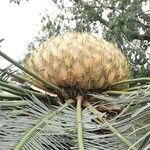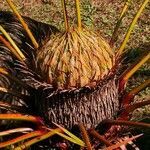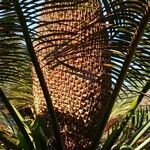Trunk cylindric, often dichotomously branched toward apex and gradually thickened toward base, up to 16 m × 60 (-90) cm, apex not tomentose; bark gray or white-gray, smooth toward base of trunk. Leaves 40-80(-100), 1-pinnate, 0.7-1.2 (-1.5) m × 20-30(-40) cm; petiole compressed orbicular in cross section, 10-35 cm, with 6-15 spines along each side above middle part; leaf blade oblong-lanceolate, flat or occasionally slightly "V"-shaped in cross section, pale brown tomentose when young; leaflets in 50-100 pairs, longitudinally inserted at 50-60° to rachis, straight to falcate, 9-20 cm × 5-7 mm, thickly, leathery, midvein flat adaxially, sulcate when dry, raised abaxially, base decurrent, margin slightly recurved, apex acute, pungent. Cataphylls triangular, 3.5-4.5 × 1.5-2 cm, brown tomentose, apex soft. Pollen cones fusiform, 30-45 × 10-15 cm; microsporophylls cuneate, 3.5-5 × 1.2-2.5 cm, densely pale brown tomentose, apex thickened, with an upcurved point 3-4 cm. Megasporophylls more than 30, tightly grouped, 13-18 cm, densely yellowish brown silky hairy; stalk 4-7 cm; sterile blade deltoid-ovate or suborbicular, 7-9 × 6-10 cm, margin pectinate, with 29-37 lobes 2.5-3.5 cm, terminal lobe subulate, 3-4.5 cm; ovules 1(-3) on each side of distal part of stalk, glabrous. Seeds 2(-4), orange, becoming dark brown, often obovoid, compressed, 4.5-6 × 4-4.7 cm; sclerotesta smooth, sarcotesta with a mixed, thick, fleshy, fibrous layer. Pollination Jun-Jul, seed maturity Feb-Mar.
More
A small cycad. It is a palm like plant. It grows 2 m tall. The trunk is unbranched. The leaves occur in a ring near the top. The leaves have leaflets along the stalk. The leaflets are 20 cm long by 1.5 cm wide. They are stiff and leathery. Male and female flowers are on separate plants. Male cones are oval and erect and central. The female cones are a cluster of round woody fruits below the top of the plant. The fruit are on long stalks. The seeds are 3-4 cm long. They are orange. They are covered by upward turning scaly blades.
Open plains and foothills, sometimes in medium to tall closed forest on deep, often clay-rich and more fertile soils, usually as part of the general shrub understorey in moderate to deep shade at medium to higher elevations.
More
A tropical plant. In Nepal they are grown between 500 and 1400 m altitude. In XTBG Yunnan.




